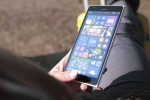SAN FRANCISCO — If it goes on your wrist or clips onto your clothing, it’s hot hot hot. And getting hotter. The huge attendance at the first-ever Wearables DevCon, held here a few weeks ago, makes that point very clearly. There are pros and cons to today’s wearables. Fortunately, the pros are becoming more pro, while the cons are becoming less con.
As someone known to carry a Pickett N600-ES slide rule in my jacket pocket, I’m long familiar with wearables. (This 5-inch aluminum slipstick model was the backup computer carried into space during the Apollo space missions.) One of the benefits of a slide rule over, say, a calculator or smartphone: No batteries to run down. On the other hand, the N600-ES didn’t include an alarm clock, a texting app, or a heartbeat monitor. Let’s call that even.
Let’s talk about some of the pros, and then look at the cons.
Pros
• Battery life and processing power continue to improve. In other words, the wearables are getting smarter, although most of them still need to be tethered or docked to a smartphone or a tablet in order to have Internet connectivity or do anything but the simplest analytics.
• The looks are getting better. I have an original Kickstarter-edition Pebble watch, which looks very 1980s. The new steel version looks far more adult and modern. However, some of my female friends say that the watch is too big and isn’t fashionable at all. (Of course, many women don’t mind big “man-sized” watches.) Cuff, another startup, is making wearables in more subtle jewelry-like designs, but the functionality is very limited. Sports bands from companies like Jawbone and Nike are getting less geeky as well.
Cons
• Battery life is still suboptimal. If I forget to charge my Pebble, it goes dead after only a few days. Worse, wearables can kill the batteries of a smartphone. The Bluetooth LE specification can drastically reduce the energy draw if both the wearable and the smartphone use that specification. I’m looking forward to when mainstream wearables can go for months—not days—without a recharge.
• Sensors aren’t very accurate, especially when it comes to activity. According to “Activity Trackers Don’t Sense Everything,” a story in the New York Times, researchers at Arizona State University put wearables to the test. Here’s what they learned:
After asking participants to engage in activities like exercise, playing games and housework, the researchers found that the trackers were able to record some but not all of the subjects’ movements. The devices reliably tracked forward motion; they counted how many steps volunteers took while walking or jogging, and accurately determined corresponding energy consumption.
But the trackers were inept at measuring volunteers’ more subtle movements, such as when they stood, played Scrabble, gently pedaled a stationary bicycle, or used a broom to sweep up around the physiology lab. Over all, the results suggest that consumer activity monitors “do not detect light-intensity activities very well,” said Glenn Gaesser, a professor and the director of the Healthy Lifestyles Research Center at Arizona State University, who oversaw one of the studies.
• People are still uneasy with head-mounted wearables, as well as those that include cameras, like Google Glass. Living in Silicon Valley, I see people wearing Glass all the time, and frankly it doesn’t bother me. Yet it’s unclear what the societal norms are going to be, and even what the law is going to be. (Some states are seeking to ban driving with head-mounted displays due to the potential for driver distraction.)
There’s also a trend for people to have video cameras attached to their clothing. Knowing that I’m captured on video by someone walking down the street, or in the shopping cart next to me in the grocery store, is rather annoying.
Given the huge response to the initial conference, Wearables DevCon is expanding and becoming Wearables TechCon—and it’s moving to Santa Clara, Calif. The conference will be March 9-11, 2015. See you there!
Alan Zeichick, founding editor of SD Times, is principal analyst of Camden Associates.






